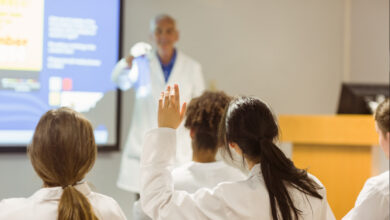HOSPITAL ROUNDS: You Never Know What You’ll Find!

Hospital rounds! Everyone has heard of them, but what are they, any way? “Hospital rounds” is a seven-day-a-week, 365-day a year procedure during which a doctor visits his hospitalized patients. These “rounds” differ from those of the postman, the newspaper boy, or the trash truck. This is the time when the progress of hospitalized patients is assessed and information from the nursing staff and the patient’s chart is evaluated. In private practice rounds are usually one-on-one—just you and the patient. Nursing staff may or may not be present.
During medical school, internship, and residency, hospital rounds are much different, however. Medical students, residents, and interns use rounds as a opportunity; time to discuss a patient’s diagnosis, laboratory results, progress toward improvement, and to point out interesting physical findings the patient displays. It is during these “educational rounds” that a variety of patients are seen and numerous situations are encountered.
As stated previously, the purpose of rounds is to visit hospitalized patient’s, ask the patient about their symptoms and how they’re feeling, and check on the progress they’re making toward recovery. Your approach depends on the reason they’re in the hospital.
Typically, several specific items are included in the doctor’s hospital visit. They are as follows:
Prior to seeing the patient, the doctor reads the patient’s chart or electronic record and reviews lab and X-ray results, vital signs, nursing notes, and other pertinent data.Upon entering the room the doctor and patient converse about the patient’s current status and symptoms.The doctor examines the patient, listening to the heart and lungs, checking the abdomen, examining dressings or wounds, checking the legs for signs of blood clots or swelling, checking any tubes, drains, etc. that may be in place.The doctor shares lab and X-ray results with the patient and discusses a plan of care based on those results and current status.The doctor leaves the patient’s room, returns to the nursing station, and writes a “progress note” in the medical record. The “note” is a summarization of the day’s visit, it’s pertinent points, exam findings, and plan of care.Based on all previous information, the doctor writes pertinent “orders,” which tell the nursing staff what steps are next in the patient’s care.
For each hospitalized patient, this routine is carried out, but is individualized according to the reason for this patient’s hospitalization, results of tests, and progress toward recovery.
Hospital rounds at a teaching hospital, one where medical students, residents, and interns (a term no longer in use) are assigned to various “services,” or wards, are completely different. In addition to the six items listed above, each patient is used as a teaching tool. Rounds are led by the “attending physician,” or faculty member, and accompanying him are one or two residents and two to four medical students.
Each patient seen on rounds is evaluated thoroughly, their diagnosis and treatment are discussed, and physical findings are pointed out and explained. At the bedside, medical students are quizzed about the patient’s diagnosis, treatment, and various other aspects of their problem. The “faculty doctor” lectures briefly about the patient’s disease and leads the discussion about it. The residents participate by asking additional questions and discussing the patient’s “work up”—the process by which a diagnosis is determined and a treatment plan is instituted. Because of the complexity of some patients, rounds can sometimes last two hours.
When a new patient is admitted to the ward, he or she is seen early on by a med student, who does a complete history and physical. The next day, on rounds, it is the med student’s responsibility to present that information to the faculty doctor. A learning session then begins, and all aspects of the diagnosis and treatment are discussed. On rounds each day thereafter, new information and results are discussed. It’s a total learning experience.
Sometimes on rounds, unexpected things occur. These events differ depending on what “service” the patient was on. Many interesting examples are presented below, categorized by their specialty area.
ENT (Ear, Nose, & Throat) Service: Tracheotomies are done and managed by otolaryngologists. On rounds, a resident was inspecting a patient’s trach when the man suddenly coughed, and spewed nasty mucus in the resident’s face.
Nosebleeds are the ENT doctor’s nemesis. Severe nosebleeds require a special inflatable packing inserted in the operating room. Removing this packing is dicey because even though it appears the bleeding has stopped, you really don’t know until you try to remove the packing. Once, on rounds, that happened necessitating an emergency trip back to the operating room. Some nosebleeds are nearly uncontrollable, and this was one.
GENERAL SURGERY Service: Tubes inserted between the ribs are used to re-inflate a collapsed lung after lung surgery or to drain fluid from the chest cavity. These tubes don’t stay in forever but are sometimes in for 7-10 days. Eight to twelve inches of tube is in the chest cavity. When one is removed, it’s often a mess. A chest tube is taken out at the patient’s bedside. After cutting the sutures that secure it, a sudden, quick pull on the tube removes it. On more than one occasion, when the tip of the tube exited, it flipped and fluid in the tube splattered on the patient, nearby students, and the wall.
Surgical wound infections are nasty. They ooze blood, drain pus, and the wound edges separate. It’s really easy to gag at the sight, or the smell, of an infected wound. Rounds was the time to check dressings, examine incisions, and look for infection. Occasionally, an infected wound was found so an inexperienced student had to develop a “strong stomach” to keep from getting sick. After repeated exposure, one’s reaction to blood, pus, and foul odor lessens.
Bowel obstructions cause nausea, vomiting, and abdominal distension. Non-surgical treatment starts by emptying the stomach and small intestine using a tube inserted through the nose, down the esophagus, and into the stomach. A suction device then keeps the stomach empty in hopes of the obstruction releasing. One patient had been in this situation for several days and became very thirsty. On rounds we noted the volume of liquid obtained from his stomach was many times greater than normal. We asked him “why.” He said he became so thirsty and dehydrated, he forced himself to drink his bath water from his wash basin, AFTER he had bathed. This did not help his bowel obstruction.
Buerger’s Disease: A circulatory disease of the small and medium arteries of the arms and legs which blocks blood flow and causes gangrene. Amputations of fingers, toes, hands, and feet are common in Buerger’s . Cigarette smoking is a cause and aggravates it, significantly. On rounds, we visited a man with Buerger’s who had lost both feet, one hand, and three fingers of the remaining hand. Between his two remaining fingers was a lit cigarette.
INTERNAL MEDICINE service: On rounds at the Veteran’s Hospital one morning, the next patient we went to see was dead. He had died just minutes before we came to see him.
Another time we came upon a man with severe chest pain in the midst of a heart attack.
Another was a man having severe pain from the waist down. Both legs were blue, pale, and cold to the touch. He had a “saddle embolus;” a clot at the lower end of the aorta blocking circulation to both legs. He had emergency surgery that morning.
The Veteran’s Hospital in Indianapolis had a host of patient’s with problems medical students were alerted to see. These patients were admitted once or twice a year for re-evaluation giving med students the opportunity to see their physical findings. One such patient was a man with Acromegaly—an over-production of growth hormone by a benign pituitary tumor that causes enlargement of the jaw bone, hands, feet, and other bones. Acromegalics have a classic appearance that all medical students should see and learn to recognize. Another was a man with cirrhosis of the liver with muscle wasting, jaundice, and ascites (fluid in the abdomen). His appearance was classic for patient’s with cirrhosis who are in late stages of the disease. Patient’s with Rheumatic Heart Disease and the murmur of mitral stenosis (narrowing of the heart valve between the left-sided chambers) were always available for students to examine. Every future doctor should hear the “rumble” and “opening snap” of mitral stenosis. And I heard “the death rattle” (a rattling sound people near death make when breathing) on rounds more than once. A few times on rounds, patients were encountered who were confused, had slurred speech, were partially paralyzed or couldn’t speak. These patients had had a stroke.
It was always aggravating when patients turned worse during the night without the nurses being aware of it, and the doctor not being informed. During morning rounds, occasionally, we would find a patient in an emergency situation in need of immediate attention.
Dr. G’s Opinion: Hospital rounds we’re one of my favorite activities of the day. Every patient was different, and every situation was a potential emergency. Hospitalized patients were always the sickest, and demanded strict attention. Seeing patients on rounds once every day was crucial to good patient care. Some patients were so unstable medically that twice daily visits were needed to keep a closer eye on them. ICU/CCU patient’s definitely needed twice-daily visits because most were medically unstable and could turn bad quickly
Learning as much as possible about patients and diseases was the purpose and benefit of hospital rounds during Med school and residency. Those were fun, enlightening days I will never forget.
References: Personal recollections of William Gilkison MD




